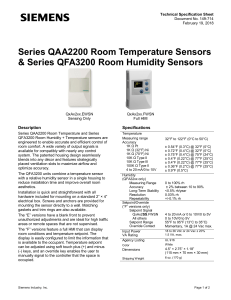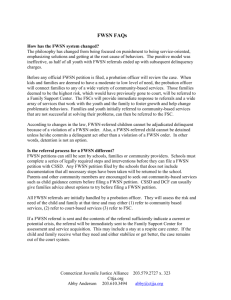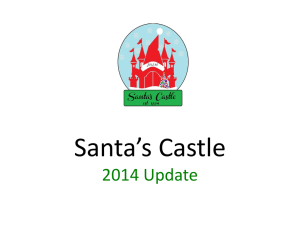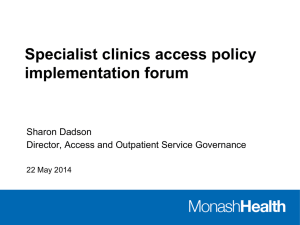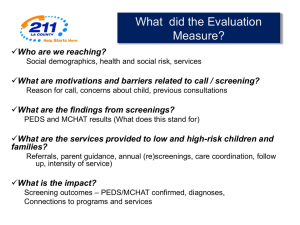Connecticut-Family-S.. - Status Offense Reform Center
advertisement
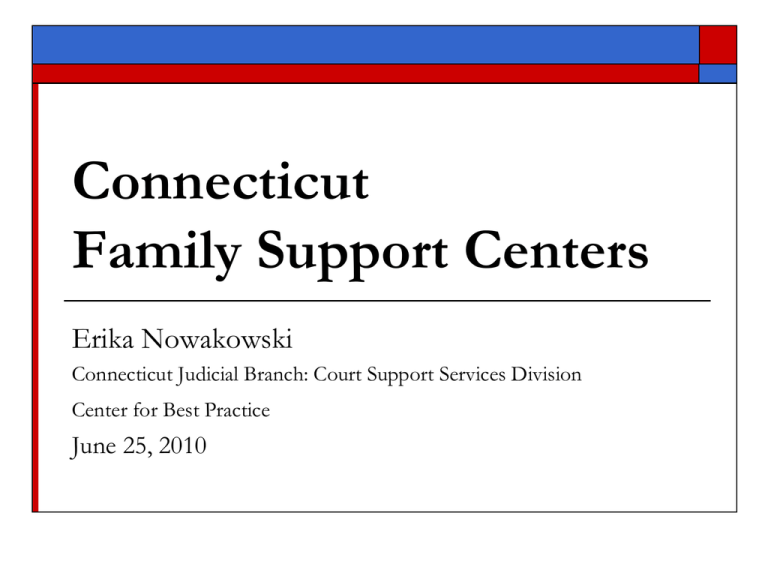
Connecticut Family Support Centers Erika Nowakowski Connecticut Judicial Branch: Court Support Services Division Center for Best Practice June 25, 2010 Systems Change for Status Offenders in Connecticut Connecticut juvenile population Impetus for Change: legislative background and target population Family Support Center model Services Screening and Assessment Interventions Implementation process: considerations and challenges Measuring and monitoring outcomes Lessons learned Definition of FWSN Five (5) categories that constitute a FWSN referral to court for a child under the age of 16: Runaway without just cause Beyond control of a parent/guardian Engaged in indecent/immoral conduct Truant from school or overtly defies school rules Age 13 – 15 and has engaged in sexual intercourse with a person 2 years of his/her age Before Legislative Change Connecticut Juvenile Court FY 2006-2007 15,857 distinct juveniles referred to court 1,675 distinct juveniles admitted to detention 10,910 Delinquency 1,212 Youth in Crisis (status offenders age 16 & 17) 3,735 FWSN referrals (status offenders under 16) Average daily population of 169 50% with FWSN history* 12% with FWSN and VOCO* 49% of FWSNs are female; 51% are male 34% of all referred juveniles are FWSN; 15% violate orders After Legislative Change Statewide FWSN Referrals Down Calendar Year 2006 Calendar Year 2007 3,638 FWSN Referrals 3,263 FWSN Referrals Calendar Year 2008 2,187 FWSN Referrals 10% reduction from 2006 40% reduction from 2006 3 year comparison of FWSN referrals 4000 3753 3500 3000 2403 2500 1872 2000 1500 1000 500 0 6/06-5/07 6/07-5/08 6/08-5/09 Decrease in Judicial Handling 10/1/06 to 4/30/07 10/1/07 to 4/30/08 1,397 non-judicial FWSN 89 judicial FWSN 10/1/08 to 4/30/09 1,222 non-judicial FWSN 1,309 judicial FWSN 1,341 non-judicial FWSN 47 judicial FWSN 0 FWSNs or FWSN Violators in Detention Decreased Violations, Commitments 10/1/06 to 4/30/07 10/1/07 to 4/30/08 30 FWSN Commitments of 181 total commitments (17%) 263 violations for FWSN & Delinquent 6 FWSN Commitments of 134 total commitments (4%) 166 violations for FWSN & Delinquent 10/01/08 to 4/30/09 8 FWSN Commitments of 151 total commitments (5%) How did we get there? Legislative Changes PA 05-250: Children of Families with Service Needs; effective October 1, 2007 Prohibits holding a child whose family has been adjudicated as a FWSN in juvenile detention, and Prohibits adjudicating FWSNs delinquent solely for violating a court's FWSN order PA 06-188: Establishes Families With Service Needs Advisory Board Legislative Changes Amendments of CGS §46b-149 included changes to: Processing FWSN referrals Time a judge may permit the matter to be continued with no adjudication (up to 6 months with a 3 month extension for cause) DCF FWSN Commitment; requires assurance of least restrictive environment Services that must be available Process for adjudicated FWSNs who violate a court order Types of environments allowable for FWSN violators New Court Referral Process New Parent Complaint Notification Form Changed the School Truancy/Defiance of School Rules Complaint Form Considerable changes in requirements for Judicial handling High-need FWSNs diverted directly to services (to FSCs in 4 areas) Role of Juvenile Probation Supervisors Screen FWSN Referrals; focus is on court diversion Refer directly to FSC (high needs indicated) OR Assign a probation officer to assess needs and refer to services All Cases Handled Non-judicially Exceptions: Continued and escalating problem behavior in conjunction with community based services being exhausted Family Support Center: Funding Judicial Branch requested state funds for 10 centers to serve 13 juvenile courts Target Highest-Need FWSNs Estimated 25% of all referred FY 07/08 state budget funded four (4) of ten, remainder of funding requested for FY 08/09 and again for FY 09/10 Funding included process and outcome evaluation Family Support Center: Referrals Probation Supervisors receive and review referrals from complainant If risk/need indicators are moderate/high, referral is sent immediately to FSC and FSC must contact the family within 3 hours If risk/need indicators are mild/moderate, case is assigned to a probation officer for standard processing If after meeting the child and/or family, probation officer uncovers more risk/needs indicators, referral to FSC can still be made DCF liaison can/is also be consulted; 3 of 4 courts instituted a triage meeting with DCF 564 referred since 10/07; 506 with intakes R eferrals and Intakes at F SC 140 120 120 111 111 103 100 85 80 72 67 71 60 40 20 0 7/ 08 - 9/ 08 10/ 08 - 12/ 08 1/ 09 - 3/ 09 4/ 09 - 6/ 09 Family Support Center: Goals To divert FWSNs from further court involvement: Offer a “one-stop,” multi-service model of care for children and their families Provide an array of services on-site Prioritize collaboration with systems, service providers and families Family Support Center: Who are the Kids? Cases are VERY Complex Multiple system involvement: Many services have already been tried Prior out of home placements Home-based services Outpatient substance abuse and mental health services Significant mental health needs Have witnessed or been victims of abuse/violence Parents have untreated and significant needs Educational challenges Stressed families Family Support Center: Client Demographics Average age is 15 75% of FSC clients are minorities Gender distribution by FSC site Bridgeport 62% M, 38% F Hartford 25% M, 75% F New Haven 54% M, 46%F Waterbury 32% M, 68% F Family Support Center: Model Underpinnings Principles of effective practice Strengths-based Gender responsive Trauma sensitive Family focused Individualized Family Support Center: Key Elements Focus on initial engagement Contact families within 3 hours of receiving the referral Must continue attempts until all options are exhausted Provide comprehensive screening, assessment and case plan (called collaborative plan) Services needed are services offered; match the child/family to the services indicated through assessment Collaboration with systems and service providers Family Support Center: Services Crisis Intervention Family Mediation Case Management/Coordination Educational Consultation/Advocacy Aftercare Services Referrals to home-based programs Flex Funds for Pro-social Activities Family Support Center: Groups Trauma Services/ Intervention Cognitive Behavioral Interventions Female-specific services Parent/ Family Skill building Family Support Center: Screening and Assessments According to the OJJDP, screening and assessment instruments are desirable if they are: Easy to read Paper and Pencil Assess mental distress and disorder and/or substance use needs Culturally sensitive Reliable and Valid Age- and Gender-based norms Family Support Center: Screening Instrument Screening instruments should: Assess psychological or behavioral conditions Have low cost and fees Be brief and simple to administer Offer easy scoring Be quick and simple to interpret Family Support Center: Assessments Assessment is defined as, “a more comprehensive and individualized examination of the psychosocial needs and problems identified during the initial screening, including the type and extent of mental health and substance abuse disorders, other issues associated with the disorders, and recommendations for treatment intervention”. (OJJDP, 2004) Family Support Center: Screening and Assessments Tools Comprehensive screening process Juvenile Assessment Generic (JAG) Suicidal Ideation Questionnaire (SIQ) Massachusetts Youth Screening Instrument-2 (MAYSI-2) If indicated, assessment is conducted Child and Adolescent Needs and Strengths with Mental Health Challenges (CANS-MH) Traumatic Events Screening Inventory (TESI) Family Support Center: Staffing & Training Staff interview process must reflect the key underpinnings of the program model Each staff must have an individual development plan Staff must be held accountable to set standards and rewarded for model adherence Training (plus coaching) must begin with how you expect staff to treat the clients Motivational interviewing Strengths-based practice Trauma sensitivity Cultural competence Gender responsivity Training on practices and interventions Process must include quality assurance and feedback to encourage improvement Family Support Center: Measuring/Monitoring Outcomes Utilize Contractor Data Collection System to collect data from FSCs Justice Research Center conducted process and outcome evaluation Quality assurance on select groups Compliance specialist ensures contract compliance CBP staff ensure model fidelity through coaching and support Family Support Center: Outcome Measures Client Level Program Level Recidivism; including referral for another FWSN Educational improvements Family functioning improvements Overall client functioning improvements Service completion rates Treatment matching Model fidelity System Level Reduction/elimination of FWSNs in detention Reduction of judicially handled FWSNs Reduction of repeat FWSNs/ FWSN delinquents Reduction of FWSN Commitments C o mpletio ns and Successful C o mpletio ns by Quarter 100 89 90 79 77 80 72 70 63 60 51 50 complet ions 42 successf ul 40 30 19 17 20 10 8 7 0 0 1/ 08 - 3/ 08 4/ 08 - 6/ 08 7/ 08 - 9/ 08 10/ 08 - 12/ 08 1/ 09 - 3/ 09 4/ 09 - 6/ 09 P ercentage o f Successful C o mpletio ns by F SC 100% 90% 90% 92% 90% 90% 83% 81% 80% 80% 73% 68% 70% 61% 56% 56% 60% 50% 50% 44% 40% 25% 30% 20% 14% 10% 0% Wat erbury F.S.C. Bridgeport F.S.C. 7/ 08 - 9/ 08 10/ 08 - 12/ 08 New Haven F.S.C. 1/ 09 - 3/ 09 4/ 09 - 6/ 09 Hart f ord F.S.C. Lessons Learned Implementation requires an active partnership between model developer and the agency implementing the model Process evaluation helps streamline program processes and activities Collaboration with referral source is paramount Must have established ties with other systems/ service providers Collect data that will help determine if outcome objectives are being met Detail processes and inform partners Connecticut Contact Information Erika Nowakowski 860-721-2199 ext 3141 Erika.Nowakowski@jud.ct.gov Kimberly Selvaggi 860-721-2171 Kimberly.Selvaggi@jud.ct.gov State of Connecticut, Judicial Branch Court Support Services Division 936 Silas Deane Highway Wethersfield, CT 06109
